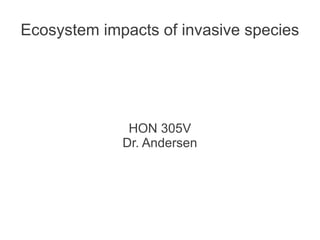
IS ecosystem effects
- 1. Ecosystem impacts of invasive species HON 305V Dr. Andersen
- 2. Why do invasives become so abundant? ● Competitive release: Kept in check by co- adapted competitors in native habitat ● Release from natural enemies: Kept in check by “the 3 P's” (predators, parasites, pathogens) in native habitat ● Facilitation: Alter habitat to make it more favorable for themselves ● Allelopathy: Poison your neighbors ● Fire regimes: Burn your neighbors' homes down
- 3. Competitive release vs. natural enemy release ● Ecologists have been debating the relative importance of competition vs. the 3 P's since the 1950's ● Still an active topic of research ● Real answer seems to be “it depends”
- 4. Allelopathy ● Yellow starthistle (Centaurea solstitialis) native to Eastern Europe, highly invasive throughout the Western U.S. ● Roots produce 8- hydroxyquinoline, toxic to plants that have not co- evolved with C. solstitialis
- 5. Altered fire regimes ● Cheatgrass (Bromus tectorum), native to Eurasia, now found throughout the Western U.S. ● Creates dense stands of dry grass (i.e., fuel) in the hottest driest summer months ● Natural grassland fire frequency in non-invaded areas about once every 60-100 years ● Heavily invaded areas burn every 3-5 years ● Native vegetation not adapted to this high fire frequency ● Neither are native wildlife
- 6. Effects on invaded habitats ● The worst invasive plants can establish near-monocultures that displace native vegetation, and reduce habitat quality for native wildlife
- 7. Back to the 3 P's ● Introduced predators can devastate native animal communities ● Feral cats ● Green tree snakes ● Many of the worst offenders are fish
- 8. Integrated strategy for combating invasive species ● Prevent additional introductions through effective quarantine and regulation ● Early detection and rapid response to new outbreaks ● Control and management of established problem species through multiple means ● Restoration and recovery of natural ecosystems
- 9. Giant African Snail (Lissachatina fulica) ● Voracious herbivore, major pest (and nuisance) in vegetable and fruit crops, and in gardens ● Feeds on a broad range of host plants ● Has established throughout Indo-Pacific, Caribbean, Brazil ● Found in the U.S. in Florida and Hawaii
- 10. Cane Toad (Rhinella marina) ● Deliberately introduced into Australia in 1935 to control pest insects in sugarcane ● Largest toad species ● Eats everything ● Toxic to anything that tries to eat it
- 11. Feral pigs (Sus scrofa) ● Originally native to Europe, Asia, and North Africa ● Now found on all continents except Antarctica ● Major problem in many areas, including (but not limited to) Australia, Hawaii, Texas ● Carry many diseases of livestock and humans including ● Foot and mouth disease ● Brucellosis ● Leptospirosis ● Toxoplasmosis ● Rooting and wallowing behavior damages native vegetation, may promote erosion ● Opportunistic omnivores (they eat everything) ● Impact water resources for wildlife
- 12. House sparrow (Passer domesticus) ● Native to Eurasia and North Africa ● Now found throughout the U.S., and in many other parts of the world ● Can out-compete native granivorous (seed-eating) birds ● Known to evict many native birds from nests ● Swallows (here on campus) ● Woodpeckers ● Bluebirds ● Wrens ● Purple Martins
- 13. Tree-of-heaven (Ailanthus altissima) ● Native to Asia ● Fast-growing, prolific seed- producer, aggressive root- sprouting; can sprout from fragments ● Allelopathic ● Thrives in poor soils, tolerates pollution ● Can form dense stands and crowd out native vegetation ● Roots can damage sidewalks and building foundations
- 14. Giant Hogweed (Heracleum mantegazzianum) ● Crowds out native species ● Dies back in winter, thus can promote soil erosion ● Produces toxic sap that can cause skin irritation and blindness ● Established in Oregon, Washington, and Pennsylvania ● British progressive-rock band Genesis (Phil Collins, Peter Gabriel) recorded a song about Giant Hogweed
- 15. Garlic mustard (Alliaria petiolata) ● Native to Europe, established in U.S. in th the 19 century ● Aggressively competitive, allelopathic ● Able to out-compete native forest-floor plants
- 16. Russian olive (Eleagnus angustifolia) ● Native to southern Europe and western Asia ● Displaces native vegetation mainly but not exclusively in riparian (streamside) habitats ● Can fix atmospheric nitrogen, shade tolerant ● Forms dense stands ● Provides poor habitat for native birds
- 17. Water hyacinth (Eichhornia crassipes) ● Native to tropical South America ● Now found in North America, Asia, Australia, Africa, and New Zealand ● In U.S. found throughout the southeast, and in California and Hawaii ● Chokes waterways, leads to massive amounts of decaying vegetation and reduced flow; reduce dissolved oxygen levels, often leading to fish kills ● Shade out other aquatic plants, as well as phytoplankton ● Biological control promising ● Can be used to make a wicker-like material that can be made into baskets or furniture ● Used in World War II in Southeast Asia to fool Japanese pilots into thinking that lakes were open fields safe for landing
- 18. ● Questions on the material? ● Questions on any of the examples? ● Remember competitive release, the 3 P's, and facilitation. What are the implications of these three mechanisms for control of invasive species? ● What kinds of adaptations might species have to cope with really high fire frequencies? ● Invasive predators and herbivores can be especially devastating on islands. Can you think of reasons why this might be true? ● What are the implications of so many widespread invasive species for our concept of “pristine nature”? ● Observations on invasive species you've encountered?
